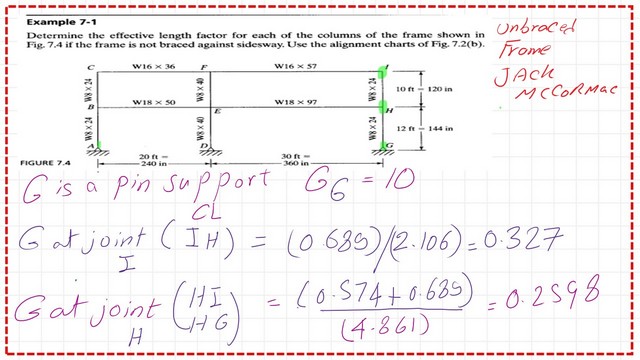Last Updated on July 21, 2025 by Maged kamel
Solved Problem For Alignment Chart for columns-7-1.
Solved problem 7-1 How to get Ix/L values for columns of the frame?
Our solved problem is solved problem 7-1 from Prof. Mccormac’s textbook, it is required to determine the effective length factor.
For each of the frame columns, shown in Figure 7-4, if the frame is not braced against sideways. Use the alignment chart of Fig 7-2 b. First, we need to open Table 1-1, which contains the properties of W sections, including inertia and radius of gyration.

We have solved this problem; there are six columns and four girders. First, we need to open Table 1-1, for the properties of W sections for the inertia and radius of gyration.
The first column is for the member name, the second column is for the column section, the third column is for its Ix value – inch4, the fourth column is for the length of the member in inches, and the last column is for the Ix/L value.
The columns are ABC, D E F, and GHI, all hinged at the three bases.
A list of Ix/L for columns AB, BC, DE, and EF. A solved problem 7-1 for the alignment chart for columns.
The second image is for the remaining two columns GH and HI. The Ix values, lengths, and the value of Ix/L.

A list of Ix/L for columns, GH&HI, is presented.
Solved problem 7-1: How to get Ix/L values for the girders of the frame?
The following image shows the data for the four beams CF, FI, BE, and EH, from table 1-1, we get all the necessary data for Ix.
A list of Ix/L for beams CF, FI, BE, and EH. The beams are arranged in a similar column; the first column is the designation, and the second column is for the section of each beam.

The third column is for the inertia value of Ix , and the last column is for the division of Ix over L, which is EI/L.
If we have finished writing all the values for beams, we will start joint by joint, first for joint A, since it is a hinge then GA is taken as 10, and for point B it is a part of column AB and column Bc, standing at joint B, then the sum( Ix/L) for columns/ sum( Ix/L of only one beam).
Adding (0.689 + 0.574 )/3.333 will give the value of 0.379.
We obtained it earlier. Please refer to the first image for an illustration of the numerator values.
We have one column and one beam, so (0.689/ 1.867 ) =0.369 for joint C.

We will move to joint F if we start with F, this joint. There is no upper column; we have only one column, the summation of Ix/L of the column / (the summation of two beams). Since this joint is intermediate, then 1.217 /( 1.86 + 2.106 )= 0.306.
We will move to joint E if we start with E. There is an upper column and a lower column; the summation of Ix/L of the columns / the sum( two beams) then (1.217+1.014) /( 3.333 + 4.861)= 0.272. for joint D GD=10.

For joint I, one column HI at the joint I. For Gi, we have (0.689) / (2.106) = 0.327.
For joint H. We have two columns, so the numerator is (0.689 + 0.574), and the denominator is (4.861 + 0), which equals 0.260. Finally, Gg = 10 is used as a hinged support.

Now we have completed the related part of the G values for each joint.
For each column, we will write the G value for each joint, as shown in the figure. Then, we will consider each column, starting with AB GA for the support = 10 and the other part GB = 0.379.
The columns BC and Gb are repeated as =0.379, and Gc is 0.369 for the column DE; Gd is 10, while GE is 0.272.
For EF the joint Ge value is 0.272, Gf value is 0.306, Gg value is 10 due to the support, the GH value is =0.26, and Gi=0.327.
G’s value for all the joints is shown in the image below.
The K values are determined via the chart, for the unbraced columns as follows for member AB, starting from the hinged support with G value = 10, and the other Gb value is 0.379, by interpolation, based on the graph, each division adds 0.10.

The value will be between 1.7 and 1.8.
Let us select another member, GH. We have two values, 0.26 and 0.327, for HI, approximately 1.1.
We have for member DE, GD = 10 and Ge = 0.272.
For the member DE, we have 10 and 0.27. The k value is 1.73, close to 1.74.
The same procedure will be repeated for all the columns.
Alignment chart for columns, unbraced columns.

The following post is – Solved Problem 13-28 For Compression Members.
For a valuable resource, please visit the following link: Concentrically Loaded Compression Members.